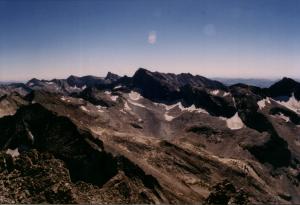
The Devil's Bedstead |

The Devil's Bedstead (in the far back) from Wildhorse canyon. |

The Devil's Bedstead over Boulder Creek. |
 Boulder Creek basin
Boulder Creek basin |
 Washington Lake and the Witch's Hat
Washington Lake and the Witch's Hat |

The saddle and the Lost River Range looking from the northwest face |

Scrambling the gullies on the northwest face |

The summit block |
 Johnstone Peak and Devil's Bedstead West from the summit
Johnstone Peak and Devil's Bedstead West from the summit |

Boulder Creek drainage from the summit |

Boulder Lake basin from the summit, Standhope Peak in the far distance
|
 The White Clouds and Castle Peak from the summit
The White Clouds and Castle Peak from the summit |
 Old Hyndman and Hyndman in the background
Old Hyndman and Hyndman in the background |

Old Hyndman and Hyndman in the background |
 The Devil's Bedstead, as viewed from Salzburger Spitzl to the south
The Devil's Bedstead, as viewed from Salzburger Spitzl to the south |
|
The Devil's Bedstead East sits at 11,865 feet. The rortheast ridge is
a class 3-4 route while the northwest face is a class 3 route. There is
some confusion as to which peak is the Devil's Bedstead, peak 11,051 to
the west or 11,825 to the east. The USGS quad and the Challis National
Forest maps designate peak 11,051 as the Devil's Bedstead while the Sawtooth
National Forest map designates peak 11,865 as the Devil's Bedstead. Surveyors
Griswold and Perkins named peak 11,865 as the Devil's Bedstead. Tom Lopez
designates the shorter, west peak, as the Devil's Bedstead West and the
taller, east peak as the Devil's Bedstead East.
Topo of the Route
Northwest Face
Photos by Tad Schafer
The climb is best taken as an overnighter in the stunning Boulder Creek
basin. The hike into the basin is an approximate 1,000 foot gain in elevation
in 3.5 miles. To reach the trailhead, drive east on the Trail Creek Road
east out of Ketchum and Sun Valley. At 22 miles turn south onto the Copper
Basin Road and drive past Copper Basin Guard Station. At 2.5 miles, turn
south onto the Wildhorse Canyon road and watch for views of Old Hyndman
to the south and the Devil's Bedstead to the west. The trailhead to the
Boulder Lake trail, FST-057, is just before Wildhorse Campground. A bridge,
at one time, crossed Wildhorse creek, but is now gone. In August, you
can forde the creek in your boots and gaitors.
Follow the well-groomed trail up a series of switchbacks for the first
half mile until you cross Boulder Creek and then climb quickly along the
left bank while Boulder Creek cuts through an impressive small canyon
on the right. The trail then crosses Boulder Creek again. At this point
look up toward the Devil's Bedstead. A few feet from the crossing you
will find a rock cairn and a faint right-hand fork to the trail. Continuing
straight will lead to a beautiful large meadow and eventually Boulder
Lake. Taking the right fork will climb the sagebrush slopes and take you
to Washington Lake at 10,000 feet and the approach for the northern saddle
and the summit of the Devil's Bedstead. You may wish to continue on another
3/4 miles to the meadow to camp overnight. Boulder Lake and additional
camp sites are another 1 1/2 miles and 500 feet in elevation. To save
time, it would be best to continue on to the meadow to camp overnight
and then, either, return to the junction and take the right fork, or bushwack
up the sagebrush and dirt slopes until the right fork of the trail is
encountered, and then proceed north along the trail to Washington Lake.
From Washington Lake, look west and find the saddle. You will need to
pick a route up through the canyon walls that border the west side of
the lake. Once above the lake, climb through the loose scree to the saddle.
At the saddle, look northeast and pick out Borah and the Lost River range
and look northwest to spot the Boulders, White Clouds, and Castle Peak.
From the saddle, instead of following the ridge north, countour around
the northwest face and choose one of the gullies. The ridge is a class
3-4 route with towers to negotiate, while the northwest face is a classic
class 3 scramble. Downclimbing will take nearly as long as the ascent.
Once on top, pick out the Devil's Bedstead West due west, Salzburger
Spitzl to the south, twin-summited Goat Peak to the south east, and Hyndman
and Old Hyndman just beyond Goat. Looking east spot Standhope Peak and
Smiley Mountain. Directlly below to the south is Kane Lake. Nearing the
abrupt east face edge, Boulder Lake can be seen below.
|

